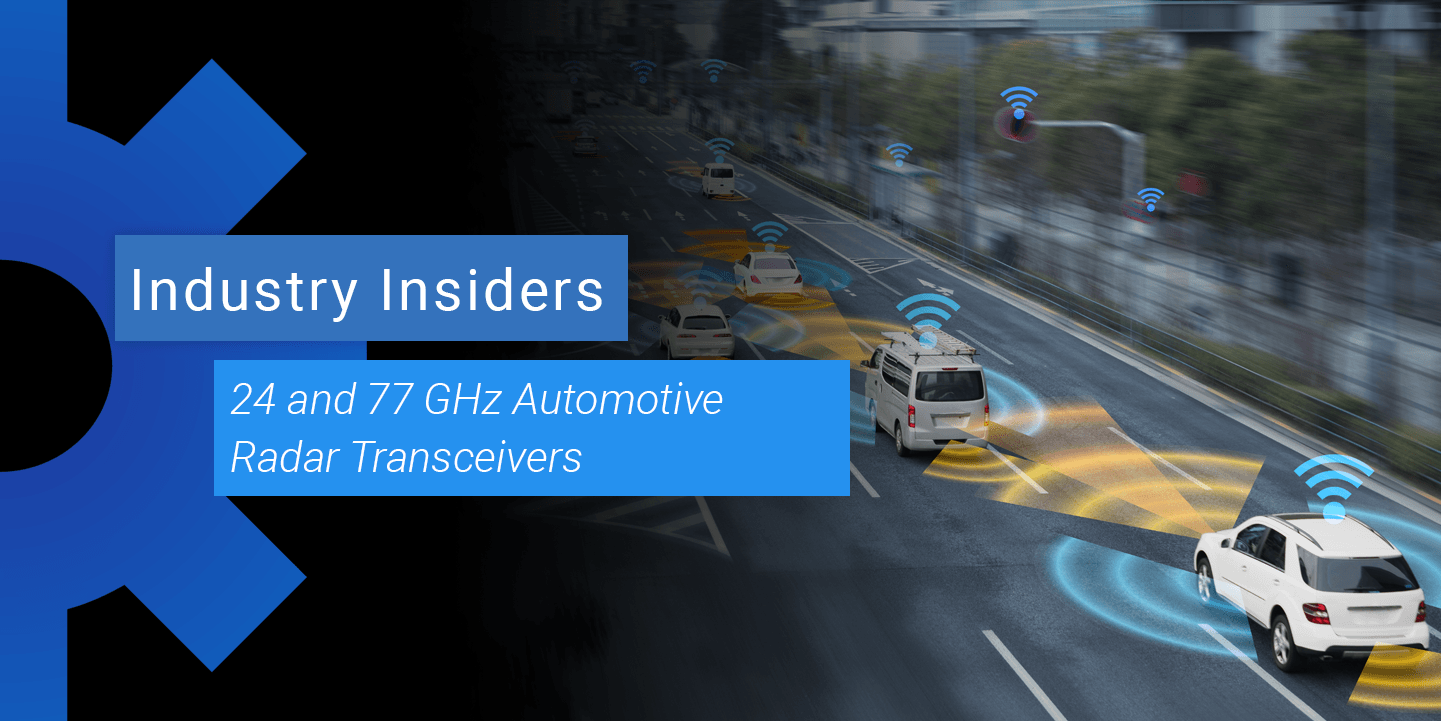
If you recently purchased a new car, then it most likely includes at least one 24 or 77 GHz radar module. These modules are already integrated with vehicle ADAS systems for object detection, automatic braking, and collision avoidance. While fully functional automotive radar modules are commercially available, you may be in the business of creating newer modules that provide higher resolution, smaller footprint, and lower power consumption. This requires selecting the right 77 GHz automotive radar transceiver for your new product.
How Does 77 GHz Automotive Radar Work?
High frequency automotive radar systems use chirped pulses (i.e., FMCW operation), where the frequency generated in the module is varied from a low value to a high value at a linear ramp rate. Chirped automotive radar is specified to operate from 76 to 81 GHz. RF transceivers for automotive radar are normally connected to series-fed patch antenna arrays to provide directionality. The output signal is then sent to an array of three Tx antennas. Newer modules will allow the user to specify a delay to provide directional detection, allowing determination of the heading of oncoming objects.
Once reflected from a distant object, the signal is detected with an array of four Rx antennas, and the Doppler shift is measured by extracting the beat frequency with respect to a 77 GHz reference oscillator signal. The beat frequency value, the phase delay in different Rx antennas, and the amplitude can all be used to extract heading, speed, and distance to a distant object.
If you’ve paid attention to the automotive radar market, then you know that 24 GHz used to be the standard frequency used for automotive radar applications. The move to 77 GHz was made for two reasons. First, the 76 to 81 GHz band allows for a broader chirp range, ultimately providing greater resolution when measuring the motion of another object. Second, using 77 GHz provides longer range as 24 GHz just happens to fall into two absorption band tails for diatomic oxygen. This means that 77 GHz automotive radar transceivers have longer usable distance, typically exceeding 100 m.
Choosing a 24 or 77 GHz Automotive Radar Transceiver
These transceivers can detect objects at both short and long ranges, and your preference might determine the frequency you need to use for your particular application. 77 GHz automotive radar is ideal for detecting objects at long range, which includes position, speed, and heading determination. 24 GHz units are best used for short-range detection of incoming obstacles.
Once a reflected signal is detected in your module and collected with your transceiver, there are some signal processing tasks that will be required in order to distinguish real vehicles from false targets, and to determine speed, distance, and heading. Some of these functions are being built into newer transceivers, as we will see below. The receiver you choose will primarily depend on the level of integration you require, as well as footprint, range requirements, and power consumption.
Infineon, BGT24ATR 24 GHz Silicon Germanium Transceiver
The BGT24ATR radar transceiver is one member of Infineon’s family of radar transceivers for use in automotive applications at 24 GHz. The manufacturer is aware of the energy efficiency importance in automotive environments; this transceiver offers low power consumption, and it utilizes a single supply voltage. This transceiver uses a single chip for receiving and transmitting channels. Some useful applications of this 24 GHz automotive radar transceiver include detection of blind spots, collision avoidance, parking assistance, and even traffic sign recognition.
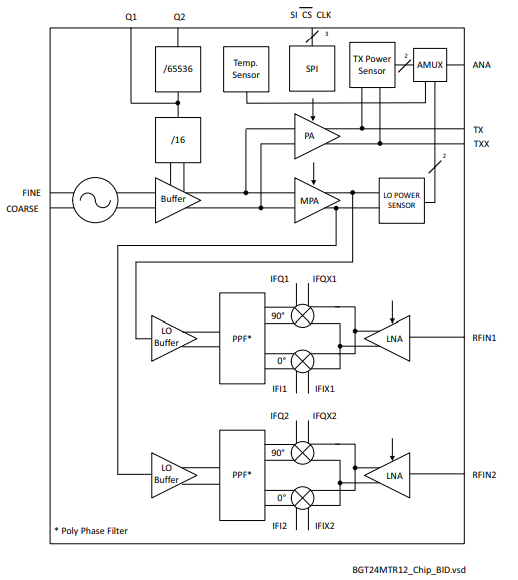 Infineon 24 GHz Radar Chipset Block Diagram, from the BGT24ATR datasheet.
Infineon 24 GHz Radar Chipset Block Diagram, from the BGT24ATR datasheet.
24 GHz is only applicable for shorter range applications, such as those listed above. However, for longer range applications requiring high resolution on position, speed, and heading detection, 77 GHz automotive radar is a better option as it provides the required broader chirp range.
Texas Instruments, AWR1243FBIGABLQ1
The AWR1243FBIGABLQ1 77 GHz transceiver from Texas Instruments is currently used in radar modules that incorporate an external MCU. An example application interface for this transceiver is shown below. This transceiver can communicate with an MCU via SPI, and the MCU communicates directly with the PHY layer.
The AWR1243 device is a self-contained FMCW transceiver single-chip solution that simplifies the implementation of Automotive Radar sensors in the band of 76 to 81 GHz. It is built on TI’s low-power 45-nm RFCMOS process, which enables a monolithic implementation of a 3TX, 4RX system with built-in PLL and A2D converters. Simple programming model changes can enable a wide variety of sensor implementation (Short, Mid, Long) with the possibility of dynamic reconfiguration for implementing a multimode sensor.
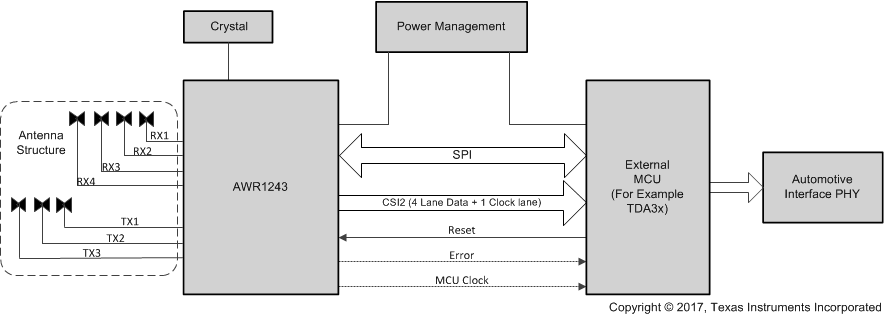 Example application diagram from the AWR1243 RF transceiver, found in the datasheet from TI
Example application diagram from the AWR1243 RF transceiver, found in the datasheet from TI
Texas Instruments, AWR1443 Transceiver
The AWR1443 Transceiver is an excellent option for a 77 GHz automotive radar transceiver that includes all the standard features for these systems. This transceiver operates at frequencies from 76 to 81 GHz, which makes it suitable for FMCW radar applications in ADAS systems. It includes the standard four Rx and three Tx channels as well as a chirp modulator. This module is ideal for sensing various obstacles at ranges from 30 to 250 meters, even in low visibility.
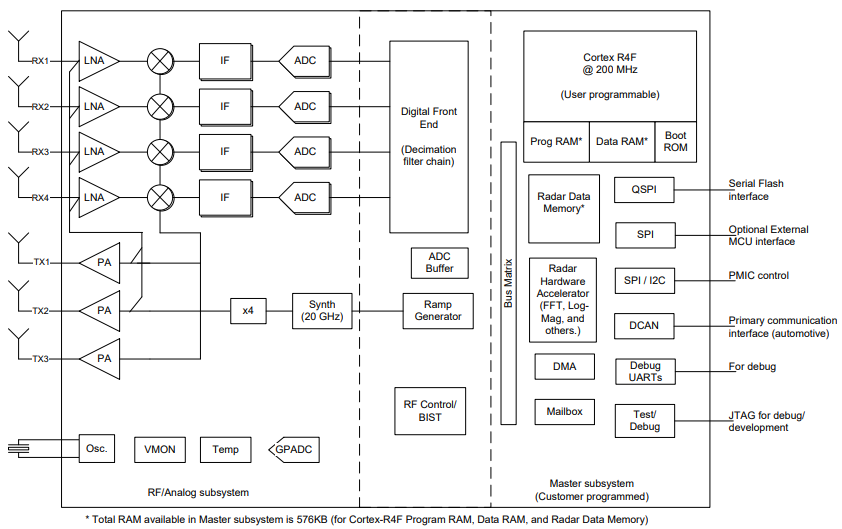 AWR1443 77 GHz automotive radar transceiver block diagram, from the AWR1443 datasheet
AWR1443 77 GHz automotive radar transceiver block diagram, from the AWR1443 datasheet
This particular system is extremely useful as it includes a number of important signal processing functions integrated directly onto the chip. This is a great option for a miniaturized 77 GHz automotive radar module as it includes many important processing functions, ultimately reducing the total size of your system.
NXP Semiconductor, TEF8102EN/N1E
The TEF8102EN/N1E is an integrated device suitable for automotive radar applications between 76 and 81 GHz. This product provides 4 GHz chirp modulation in FMCW radar, providing competitive object resolution with low noise and high output power. The rated operating temperature range can reach as high as 125 oC. If you use a master/slave setup for cascading, you can expect different LO in and LO out options. This component is compliant with the ISO26262 standard.
Some example applications of this 77 GHz automotive radar transceiver are rear and front traffic alerts, parking assistance, and collision avoidance. It is worth noting that the component has a very small footprint. The mm-wave front end part offers flexible chirp control with up to 2 GHz chirp bandwidth and three transmit chains with phase control and output level stabilization, allowing accurate determination of heading:
The phase of the TX signals can be controlled on a chirp-to-chirp basis by the timing engine, or by digital I/O signals directly connected to the binary phase shifters of different TX sections. Each receive chain contains programmable high-pass filters for suppression of strong low frequency signals, as well as low-pass filter functionality for suppression of signals in the ADC aliasing band. Source: TEF8102EN/N1E datasheet
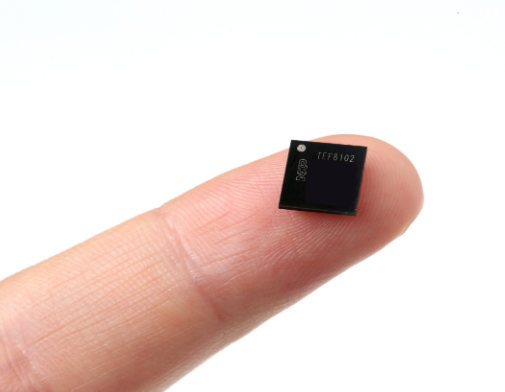 TEF8102EN/N1E transceiver chip, from NXP Semiconductor
TEF8102EN/N1E transceiver chip, from NXP Semiconductor
Also manufactured by NXP, the MC33MR3003AXVKR2 is a future release of this class of components; the company claims this newer transceiver will be top of the line. NXP has still not released this component, but expect this component and other upgrades to provide greater integration to compete with components like the AWR1443 presented above.
With 77 GHz automotive radar soon to become a standard component on new vehicles, and possibly on new UAVs, you’ll need transceivers that can support this important technology. If you’re looking for an integrated transceiver for 77 GHz automotive radar, try using our Part Selector guide to determine the best option for your next automotive product.
If you found this article interesting, make sure you stay up-to-date with our latest articles by signing up for our newsletter.